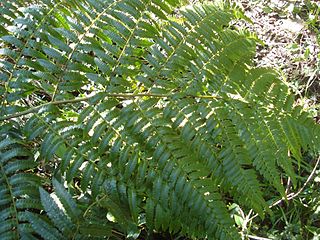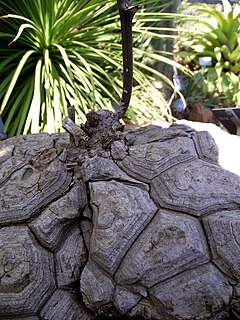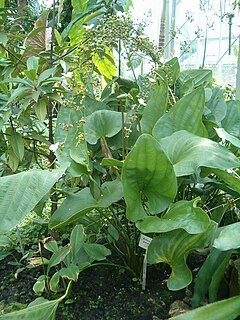
Grias is a genus of flowering plants in the family Lecythidaceae, described by Linnaeus in 1759. It is native to northwestern South America, Central America, and Jamaica.

Sphaeropteris medullaris, synonym Cyathea medullaris, commonly known as mamaku or black tree fern, is a large tree fern up to 20 m tall. It is distributed across the south-west Pacific from Fiji to Pitcairn Island. Its other Māori names include katātā, kōrau, or pītau.

Ugni is a genus of plants in the myrtle family Myrtaceae, described as a genus in 1848. It is native to western Latin America from the Valdivian temperate rain forests of southern Chile and adjacent regions of southern Argentina, north to southern Mexico.

Cyathea affinis is a variable species of tree fern native to Fiji, Samoa, the Cook Islands, Austral Islands, Tahiti, and the Marquesas Islands. The trunk of this plant is erect and 2–6 m tall. Fronds are bipinnate and 2–3 m in length. The rachis and stipe are pale to brown in colour, or flushed with red towards the pinnule rachis. The stipe is sparsely covered in narrow basal scales, which are pale to dark and have broad fragile edges. Characteristically of this species, the lowest one or two pairs of pinnae may be slightly reduced and occur towards the base of the stipe. Sori are located near the pinnule midvein and are partially or fully covered by indusia, which open towards the pinnule margin.
Alsophila biformis, synonym Cyathea biformis, is a species of tree fern native to New Guinea and the Maluku Islands, where it grows against trees in mossy forest and rain forest at an altitude of 850–2200 m. The climbing trunk is very thin, only 1–2 cm in diameter, but can reach 3 m in height. The apex of the trunk is covered in scales. Two types of fronds are produced, simple pinnate fronds, which are sterile, and bipinnate fronds, which may be fertile. The stipe is smooth, glossy and very dark, almost to the point of being black. It is covered at the base with long, very dark scales that have a pale margin. Fertile pinnules are distinctly stalked and lobed. Sori occur in four pairs per pinnule lobe and lack indusia.
Alsophila cuspidata, synonym Cyathea cuspidata, is a widespread species of tree fern native to Central and South America, where it grows in tropical rain forest up to the montane zone, as well as in open sites, on riverbanks and cleared pastureland at an altitude of 0–800 m. Its natural distribution covers Mexico, Guatemala, Belize, Honduras, El Salvador, Nicaragua, Costa Rica, Panama, Colombia, Ecuador, Peru, Bolivia, Paraguay, the Amazon Basin, Brazil and French Guiana. This species often has multiple trunks, which may be 15 m tall and about 10 cm in diameter. They are covered in black spines and together form a medium-sized, feathery clump. Fronds are bipinnate and 2–3 m long. The rachis and stipe are brown to dark brown and are covered with scales. The scales are bicoloured, having a dark brown to blackish centre and a pale, whitish margin. Pinnule veins sometimes have small, brown, star-shaped scales. Sori are round and form on either side of the pinnule midvein. They are covered by globose indusia.
Alsophila dryopteroides, synonym Cyathea dryopteroides, is a tree fern native to Puerto Rico, where it grows where it grows in shaded areas and cloud forest at an altitude of 1000–1200 m. The erect trunk may be 1.3 m tall and approximately 5 cm in diameter. Fronds are pinnate and up to 1.6 m long. The rachis is often purplish brown and covered with scales, usually on the underside. The scales range in colour from golden brown to bicoloured. Sori occur along each side of the pinnule midvein and indusia are cup-like.

Alsophila erinacea, synonym Cyathea erinacea, is a species of tree fern native to Mexico, Costa Rica, Panama, Venezuela, Colombia, Ecuador, Peru and Bolivia.
Alsophila fenicis, synonym Cyathea fenicis, is a species of tree fern native to the Philippines, Taiwan, and Orchid Island, where it grows in wet forest, forest margins and on hillsides. The trunk is erect, up to 1 m tall and about 6 cm in diameter. Fronds are tripinnate and 1.5–2 m long. Characteristically of this species, the lowest pinnae are usually reduced. The stipe is spiny and ranges in colour from brown to purple-dark brown. It bears two types of scales: long dark brown scales as well as minute brown ones. Occasionally the scales are pale. Sori are round and arranged in two rows, one on either side of the pinnule midvein. They are covered by very small indusia that resemble scales in appearance.

Cyathea delgadii is a widespread species of tree fern. It is native to Central America, and much of South America. The specific epithet delgadii refers to Gancho do Generale Delgado, along the road to Caldas Novas, Brazil, where the type material was collected.
Alsophila metteniana, synonym Cyathea metteniana, is a species of tree fern native to the Ryukyu Islands, Japan, and Taiwan, where it grows in wet forest, forest margins, and on hillsides. The trunk of this plant is erect, up to 1 m tall, and 6–10 cm in diameter. C. metteniana has tripinnate fronds that are 1–2.5 m long. The stipe is brown to purple-black in colouration. It is covered in long, broad-based scales that are usually bicoloured. Sori are round, lack indusia, and occur in two rows, one on either side of the pinnule midvein.

Couratari is a genus of trees in the family Lecythidaceae, first described as a genus in 1775. They are native to tropical South America and Central America.

Dioscorea mexicana, Mexican yam or cabeza de negro is a species of yam in the genus Dioscorea.

Echinodorus grandiflorus is a plant species in the Alismataceae. It is native to Brazil, Paraguay, Uruguay, Argentina, Venezuela and Florida.

Ardisia escallonioides, the Island marlberry, is a plant species native to the West Indies and neighboring areas. It has been reported from Barbados, Bermuda, the Dominican Republic, Cuba, Mexico, Belize, Guatemala and Florida.
Calycolpus warscewiczianus is a plant species native to Nicaragua, Costa Rica, Panamá and Venezuela.
Cissus anisophylla is a plant species known from lowland rainforests of Panamá, Colombia, Chiapas, Brazil, Perú, Costa Rica and Ecuador.
Persea brevipetiolata is a plant species known from the Mexican States of Oaxaca and Veracruz. It is found in lowland forests in the Isthmus of Tehuantepec at elevations less than 250 m.

Echinodorus grisebachii or Echinodorus amazonicus is commonly known as Amazon sword plant, although other plants are also known under this common name. The aquatic plant is cultivated for and used in ponds and artificial aquatic habitats. It is native to Cuba, Central America, and South America as far south as Brazil and Bolivia. It has been sold under the name Paniculatus.

Fischeria is a plant genus in the family Apocynaceae, first described as a genus in 1813. It is native to South America, Central America, southern Mexico, and the West Indies.











